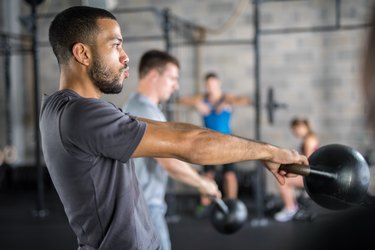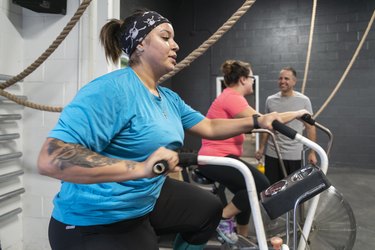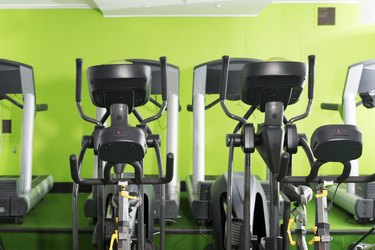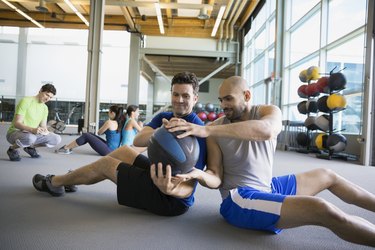
Here's an all-too-common scenario: You find a conveniently located gym you actually like, pay your membership dues, then show up for your workout and can't decide what to do first.
"Too often, people enter the gym and wander aimlessly," says Michael Moody, a personal trainer and host of the podcast The Elements of Being.
While you don't need to be a personal trainer to develop a good gym routine, you do need a basic plan. "It requires a strategic, thoughtful approach with your strengths and weaknesses in mind," Moody says. "Otherwise, you may waste time jumping randomly from one exercise to the next, or worse, [be] putting yourself at risk for an injury."
Don't let that happen to you. Here, find an effective plan that helps you reach your goal — whether that's getting started, losing weight, building muscle or having fun — and stick with it.
Tips for Getting Started at the Gym

On your very first (often disorienting) visit to the gym, ask for a tour from a personal trainer or other member of the staff so you know where to find the cardio equipment, free weights, weight machines and group exercise classes. And don't be embarrassed to ask the staff how to use something: That's their job!
You'll also want to brush up on your gym etiquette, including cleaning up after yourself. This might seem obvious, but it's your job to re-rack your weights and wipe your sweat off the machines. But the best tip for newbies is to find a workout you enjoy. If you don't like what you're doing at the gym, do something else.
Here's what to expect before your first trip to the gym.
Beginner-Friendly Gym Workouts

When it comes to actual beginner workout routines for the gym, the key is to start small, says Los Angeles-based fitness coach Andrew Heffernan. "Learn a few moves, work till you feel a little sweaty and leave before you get exhausted or bored," he says.
Follow the age-old KISS (Keep It Simple, Silly!) method and pick a cardio machine that best suits your needs and comfort level. Common starter machines include:
- The treadmill is one of the simplest ways to get moving (just start walking!) and find your ideal pace in a controlled environment.
- The elliptical is an ideal alternative to high-impact workouts for people who have joint issues but still want full-body cardio.
- The stationary bike is another good low-impact option that focuses on the lower body.
Finish your visit with a couple of strength-training exercises, such as body-weight squats, modified push-ups or medicine ball tosses against a wall (aka wall balls), then pat yourself on the back for nailing your first gym workout.
Avoid wasting your time wandering around the gym and follow these beginner workouts instead.
Calorie-Torching Gym Workouts to Help You Lose Weight

Every good long-term weight-loss plan involves a reduced-calorie diet and daily physical activity. (No, it's not sexy or flashy, but it works!) The diet part can get a little complicated, but the physical activity part requires two basic things: cardio and strength training.
Any exercise done consistently over time can help you lose weight, but high-intensity interval training (HIIT) can get you to your goal more efficiently. By alternating between bouts of all-out effort and shorter rest periods, you'll continue burning calories at a higher rate after a HIIT workout than after steady-state activity, according to the American Council on Exercise.
The best part: You can combine HIIT with either cardio or strength training. For cardio, alternate between running and walking on the treadmill. And for strength training, do a few of your favorite body-weight exercises for 20 seconds, rest for 10 seconds and repeat for a DIY Tabata workout.
Finding a workout you'll stick with is key to losing weight at the gym.
Get Ripped at the Gym

Strength training is a must for everyone, not just people who want to "get swole." Whether you use free weights, weight machines or your body weight, the only way to build muscle is with a challenging amount of resistance.
In order to build muscles up, you first have to break them down, which is what happens when you pick up heavy things like barbells, dumbbells and kettlebells (and even your own body), says exercise physiologist Jim White, RDN, owner of Jim White Fitness & Nutrition Studios.
The best moves are called compound exercises, says exercise physiologist Pete McCall, CSCS, certified personal trainer and host of the All About Fitness podcast. "Exercises like the push-press, deadlift, front squat, bench press and clean will work multiple muscle groups at once and are more time-efficient than isolation work," he says.
This strength-training plan is perfect for building muscle at the gym.
Add Variety With Circuit Training

Doing the exact same thing month after month at the gym leads to boredom and, worse, diminishing results. Switch things up once in a while with circuit workouts. These involve doing a few moves in a specific order, at a set number of reps, for a set number of rounds. For example: 4 rounds of 10 pull-ups, 15 push-ups, 20 air squats and 25 sit-ups.
Circuit training is endlessly versatile and customizable to your goals. "Someone who is looking to improve their cardio might do 1 round after the other without rest — or even as fast as possible — while someone who is looking to build muscle might rest after every movement," says physical therapist Grayson Wickham, CSCS, founder of Movement Vault.
With gym circuit workouts, your fitness routine will be anything but boring.